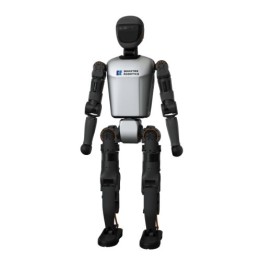Robot humanoïde Booster T1
The Booster T1 is a next-generation humanoid robot designed for researchers, engineers, and innovation labs. Developed by Booster Robotics, this open-source platform combines mechanical robustness, embedded intelligence, and software flexibility.
An advanced open-source robotic platform for research and development
Designed for high performance
With its lightweight design (30 kg) and 23 to 41 degrees of freedom, Booster T1 delivers smooth, realistic mobility, ideal for executing complex motions such as standing up from the ground or performing dynamic movements (e.g. sports, martial arts). Its shock-resistant structure supports real-world experimentation.
Built-in advanced technologies
- Nvidia AGX Orin GPU – up to 200 TOPS of AI performance
- Depth camera for 3D vision
- 9-axis IMU for posture control
- Microphones and speaker for voice interaction
- Battery life: 2 to 4 hours (10.5Ah battery)
- Wi-Fi 6, Bluetooth 5.2, 5G optional
Open platform for developers
The T1 is fully open-source and ROS2 compatible, with a comprehensive API for high-level control, feedback, and easy integration with simulation environments:
- Isaac Sim
- Mujoco
- Webots
It also supports multimodal interactions:
- Optional edge LLM
- Text-to-Speech and Automatic Speech Recognition
- Advanced perception algorithms (e.g. Yolo)
Mobile control and monitoring
A mobile app connected via Bluetooth allows real-time control, parameter adjustments, and live feedback.
Accessories to go further
- Gripper EG2-4C2: electric gripper with wide stroke, auto-locking, precise control
- Dexterous Hands RH56DFX: high grip strength, tactile sensors, native ROS compatibility
Use cases
- Higher education: hands-on learning in humanoid robotics
- Scientific research: perception, locomotion, HRI
- Product development: AI prototyping and integration
The Booster T1 is a lightweight, high-performance, open-source humanoid robot designed for developers and researchers, featuring a complete API, ROS2 compatibility, and advanced simulation and AI capabilities.




